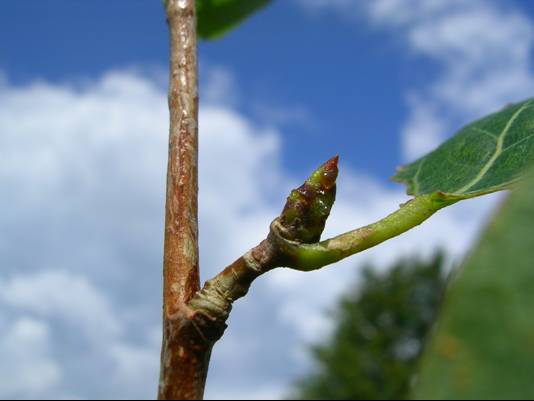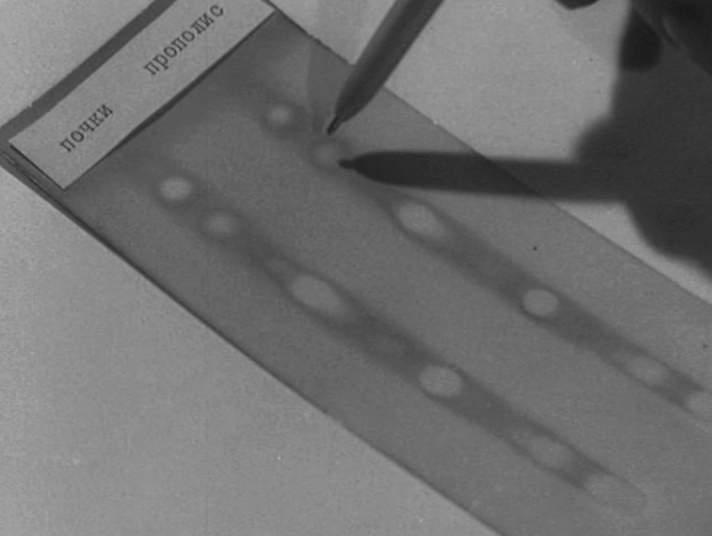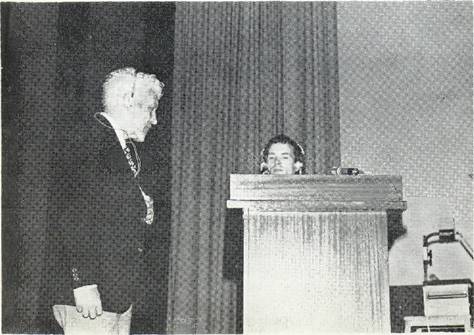- And how did events develop further? I began my working day at laboratory at 4 in the morning and secretly devoted myself to preliminary researches in order to arouse interest of scientific bosses and convince them of reasonability and necessity of works on this theme. And finally they agreed to allocate me all necessary resources. Research of chemical nature of propolis and identification of its sources were accomplished on the best equipment such as: all kinds of high performance chromatography, chromatography-mass-spectrometry, NMR. We isolated all basic characteristic components of propolis and proved their structure (bioflavonoids, phenolic triglicerids, seksviterpens, unsaturated aromatic acids and their ethers). We managed to identify about 50-70 compounds. Odorous resinous release of under-leaf-bearing (alar) kidneys of Russian white birch (Betula pubescens) or Ā«birch tearsĀ» with which a tree in warm and hot seasons "cries" appeared to be the main source for bees of Central Russian plains. It was a tremendous fact! By results of chromatography-mass-spectrometric identification the main characteristic nucleus of biologically active compounds, released from balms of birch kidneys, coincided completely with characteristic nucleus of the compounds received from collected propolis. Moreover, it appeared that russian people had used these substances in baths with birch brooms for a long time. If you attentively sniff, you find out easily that aroma of fragrant propolis in a beehive and smell of the hot steamed out broom in a bath ā is the same! That is, both bees and people independently from each other used long since healing force of Ā«birch tearsĀ» for protection and strengthening their health, and these substances were carefully selected and certificated during long time as best of the best. It was a beautiful and precise chemical picture which indicated the sources of Russian macrobiotics. First publications, concerning the whole cycle of the research works and their results, appeared in 1969 in magazine Ā«Chemistry of natural compoundsĀ». They actually blown up the scientific world! I received letters and inquiries about my article worldwide . The big glory suddenly fell upon us. In 1978 on the 2-nd International symposium on apiherapy in Ljubljana (Yugoslavia) Remi Shoven, who was in the chair, handed me over the gold award, and his post-graduate student Phillip Marshalan started studying Russian in order to read my works in original. Phillip wrote 2 big review about our researches called Ā«Investigation of propolisĀ» in the main French apitherapeutic magazine Ā«Apiculture de FranceĀ». After that a trail of big western glory extended to the USSR. Publications in different magazines began: Ā«About propolisĀ» in the magazine Ā«Science and lifeĀ», Ā«Secret of birch tears and beer glueĀ» in Ā«Chemistry and lifeĀ» in 1975, articles in newspapers Ā«NewsĀ», Ā«LabourĀ». I was invited to speak on the all-USSR radio. In 1978 a popular science film Ā«Almost opened secretĀ» which often forestalled show of feature films at cinemas was shot. But all this was devoted only to the success of scientific achievements, the way to emulsion and cosmetics was still ahead, and all problems and prickles were ahead either. - When was this new emulsion created? The new emulsion was fated to be born only 10 years later - at the end of 80th. And it took approximately the same period to adapt to the consumer and market conditions. This period coincided with period of Ā«PerestroikaĀ» in our country and its entry in world economic and competition with known western manufacturers of cosmetics. However, the genuine quality always finds its road and meets with public recognition. Western scientists called our northern Russian propolis the Ā«Russian penicillinĀ» after its strong antimicrobial properties had been found out. As we know, air in a birch wood is cleaner than in many sterile operating rooms. Our colleagues - scientists from the Institute of chemical physics called it Ā«Antioxidant bombĀ» after revealing in its composition substances with extremely high antioxidant activity - ability to suppress action of active radicals - peroxides. The matter is that resinous balms of Ā«birch tearsĀ» ideally protect green gentle skin of kidneys before they transform into leaves, actively working with the sun. Reaction of the West for opening a source of Russian propolis and its prospects was momentary and explosive. Probably it was connected with the fact that France, Bulgaria, Czech, Yugoslavia and Poland were initially oriented to use products of beehives in medicine and cosmetics. And more than 60 % of all apitherapeutic drugs made in Europe were based on propolis. It should be said that lag in studying of its chemical nature and as consequence - absence of precise system of standardization on concrete compounds and certifications of types applied the brake to wide use of propolis in various branches of medicine and cosmetics. Apitherapeutic drugs proposed by the market in that time were complex multicomponent mix compositions. And they could hardly compete with officially "chemicalized" medicine and cosmetics based on precise formulas of used compounds. That is why it is difficult to overestimate the contribution of the Soviet science. Due to it propolis got access to full chemical Ā«certificationĀ». And the opportunity of its division on types according to concrete characteristic compounds in concordance with criteria and methods of chemical taxonomy appeared only after our researches. It was then propolis could receive the admittance to official medicine, cosmetics and other spheres of producing goods for health. We have created system of color high-sensitivive reactions, effective and fast chromatographic testsāmedics, allowing to distinguish and choose the most valuable kinds and samples of propolis, to give them strict chemical-taxonomical characteristic or Ā«the biochemical passport of propolisĀ». These Ā«historical samplesĀ» - compounds, which we released and identified for the first time, as well as methods of their definition (first of all, UF-spectrophotometry of bioflavonoids), became the basis of the unified methods of certification of propolis in our country and abroad. In our country - for development of technical specifications for manufacturing such drugs as Ā«PropoceumĀ» (Tallinn) and Ā«ProposolĀ» (Biisk). Abroad, in different countries (Brazil, Canada, USA, China, Bulgaria, Czech, and others) - they formed the basis for detailed researches and certification of various samples of local propolis. The same techniques became the basis for standardization of production of companies Sigma and Biomedicals (USA), major world manufacturers of reference samples of reagents and chemical preparations. At that time I often received offers from famous Yugoslavian pharmaceutical companies Ā«MedoksĀ» and Ā«KRKĀ» on participation in joint development of drugs on basis of propolis. I want to say that propolis is a driving force of apitherapy. It was our country where nearly 80% of all characteristic coumpunds of propolis were irreproachably identified. It is necessary to emphasized that we were lucky to investigate the best, most chemically and biochemically significant northern Russian propolis, Ā«Russian penicillinĀ», which source were so called Ā«birch tearsĀ». In addition it appeared to be the least allergenic in comparison, for example, with the propolis collected by bees from kidneys of a black poplar in the countries of Southern, Central and Western Europe. We happened to study a classical type of propolis, which was certainly the best by its antimicrobial and antioxidant properties. It was nonrandom that they called it Ā«Russian penicillinĀ». To understand in details "chemistry" of such product meant neither more nor less than to rise to higher level in choosing means of protection of human being from two the most dangerous influences of environment - free radicals-peroxides and pathogenic microflora which could not overcome his protective barriers during tens millions years... to part 1 >>> to part 3 >>>
|





